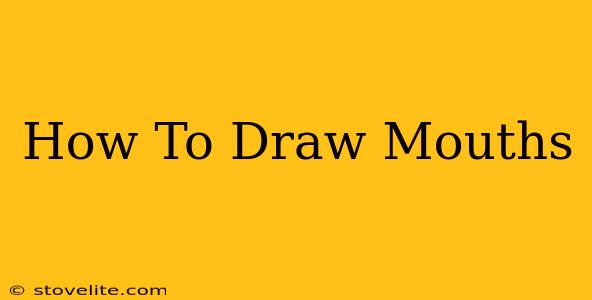Drawing a convincing mouth might seem simple, but it's a surprisingly nuanced part of the face. A well-drawn mouth can bring a character to life, conveying emotion, personality, and even age. This comprehensive guide will walk you through various techniques and approaches to help you master the art of drawing mouths.
Understanding the Anatomy of a Mouth
Before diving into drawing techniques, let's understand the basic anatomy. A mouth is more than just a simple line; it's a complex interplay of muscles, lips, and teeth.
Key Features to Observe:
- Upper Lip: Notice its cupid's bow shape and the subtle curves and dips.
- Lower Lip: Observe its fuller, softer appearance compared to the upper lip.
- Philtrum: The vertical groove between the nose and upper lip. This is a crucial element in creating realism.
- Mouth Corners: The way the corners turn significantly impacts the expression. A downturned corner suggests sadness, while an upturned one implies happiness.
- Teeth: While often partially hidden, their shape and position influence the overall appearance of the mouth.
Different Techniques for Drawing Mouths
There are several approaches you can take when drawing mouths, each with its own benefits:
1. The Basic Shape Method:
This method starts with simplifying the mouth's shape into basic geometric forms, like a slightly curved line for the lips or a combination of curves for a more complex shape. From this foundation, you can gradually add detail.
- Step 1: Sketch a simple line representing the overall shape of the mouth.
- Step 2: Refine the line, adding the cupid's bow and the fuller lower lip.
- Step 3: Add subtle details like the philtrum and the corners of the mouth.
2. The Construction Method:
This more advanced technique uses underlying anatomical structures to guide your drawing. It involves sketching the underlying muscles and then shaping the lips around them, giving a more realistic and expressive result.
- Step 1: Lightly sketch the underlying muscle structure of the mouth.
- Step 2: Build the lips over this structure, paying attention to the volume and the way the muscles influence the form.
- Step 3: Add details such as lip lines and shadows to enhance the realism.
3. The Photo Reference Method:
Using photo references is an excellent way to learn and improve your drawing skills. Find photos of different mouths and expressions and try to replicate them, paying close attention to the subtle details and variations.
- Step 1: Choose a high-quality photo of a mouth.
- Step 2: Break down the image into simpler shapes to better understand its structure.
- Step 3: Gradually add details, focusing on accurate proportions and shading.
Mastering the Art of Shading and Expression
The key to drawing realistic and expressive mouths lies in effective shading and the understanding of how light and shadow interact with the lips' form.
Shading Techniques:
- Value Studies: Practicing value studies will improve your ability to accurately capture the subtle variations in light and shadow on the lips.
- Highlighting: Carefully placed highlights can create a sense of volume and dimension.
- Shadowing: Use shadows to define the folds and creases in the lips.
Conveying Emotion:
The position and shape of the mouth greatly influence the expression. Practice drawing mouths with different emotions, such as happiness, sadness, anger, and surprise. Experiment with the corners of the mouth, the tension in the lips, and the overall shape.
Practice Makes Perfect
Drawing mouths, like any skill, requires consistent practice. The more you draw, the better you'll become at observing subtle details and rendering them accurately. Don't be discouraged if your early attempts aren't perfect – keep practicing and experimenting with different techniques. Experiment with different mediums like pencils, charcoal, or even digital tools. And most importantly, have fun!

